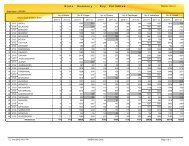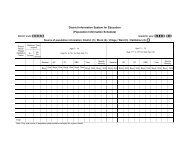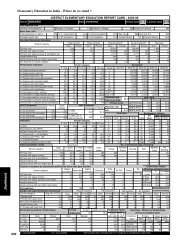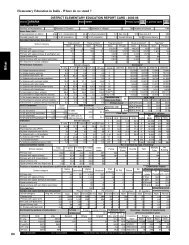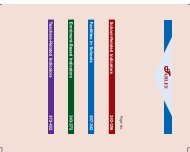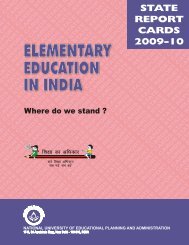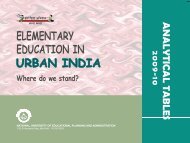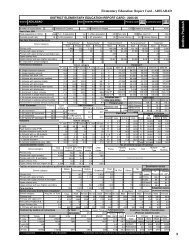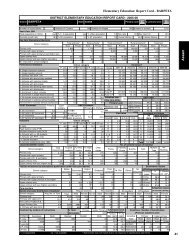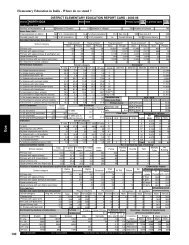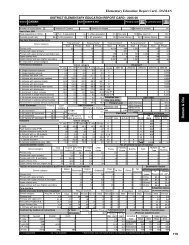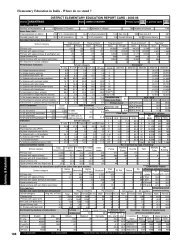Teacher-Related Indicators - DISE
Teacher-Related Indicators - DISE
Teacher-Related Indicators - DISE
- No tags were found...
You also want an ePaper? Increase the reach of your titles
YUMPU automatically turns print PDFs into web optimized ePapers that Google loves.
<strong>Teacher</strong>-<strong>Related</strong> <strong>Indicators</strong>million teachers. About 86 percentPrimary school teachers arelocated in rural areas. On the otherhand, every fourth teacher is foundto be teaching in independentElementary schools (28.79percent/1,31,7058 teachers). The percentage ofteachers in such schools in rural and urban areasis 28.09 and 31.44 respectively (Tables E1 andE2) which is quite similar to their respectivepercentages in the previous year 2004-05. In othertypes of schools, the percentage varies between5.91 in integrated Higher Secondary schools to10.79 (4,91,491 teachers) in Upper Primaryattached to Secondary & Higher Secondaryschools. Independent Upper Primary schoolsreported 4,02,161 teachers which is 8.88 percentof total teachers.Obviously, because of the state size, thehighest number of teachers is in Uttar Pradesh(0.53 million), that is, 11.24 percent of the totalteachers in the country. On the other hand,among major states, Himachal Pradesh (52,778;1.23 percent) and Uttarakhand (51,507; 1.10percent) have the least number of teachers. Delhireported 64,284 teachers which is 1.38 percentof the total teachers imparting elementaryeducation. The total number of teachers in Delhiis more than the same in a number of other bigstates. Barring Manipur, all other five newlycovered states reported only a few teachers.Manipur has 21,920 teachers which is 0.47percent of the total teachers impartingelementary education across 604 districtscovered under <strong>DISE</strong> in 2005-06.Uttar Pradesh also has thehighest number of teachers inPrimary schools (0.38 million),which is 18.46 percent of the totalPrimary teachers in the country.Daman and Diu has the leastnumber of teachers in Primary“Number of Primaryteachers increasedfrom 1.59 million in2002-03 to 2.06 millionin 2005-06’’“Obviously, because ofthe state size, the highestnumber of teachers is inUttar Pradesh (0.53million), that is, 11.24percent of the totalteachers in the country’’schools (170) in 2005-06, whileDelhi has 18,567 (0.90 percent)teachers. Madhya Pradesh,Maharashtra, Rajasthan, TamilNadu and West Bengal alsoreported a large number ofPrimary school teachers matching theirrespective sizes. All the north-eastern statesreported small number of Primary schoolteachers.The total number of teachers cannot provideany information about the availability of teachersin an individual school type unless the same islinked to the total number of schools in a schoolcategory. For this purpose, average number ofteachers by school category is presented andbriefly analysed (Table E3).Average Number of <strong>Teacher</strong>sThe average number of teachers in a schoolimparting Elementary education has shownimprovement during the period 2002-03 to 2005-06. Such schools/sections have had moreteachers in 2005-06 than in the previous yearwhich is true for all school types. By and large,this is also true for rural and urban areas, barringintegrated Higher Secondary schools which hadless number of teachers in 2005-06 than in theprevious year. The all-India average of all districtsreveals that in 2005-06, on an average, there are4.19 teachers (4.02 teachers in 2004-05) in aschool that imparts elementary education. Asignificant difference is noticed in the availabilityof teachers in rural areas (3.76 in 2005-06, 3.61in 2004-05, and 3.58 teachers in2003-04) and in urban areas(7.40 in 2005-06, 7.25 in 2004-05,and 7.03 teachers in 2003-04. Awide difference is also seenbetween schools managed bygovernment (3.62 in 2005-06,3.47 in 2004-05, and 3.43183




